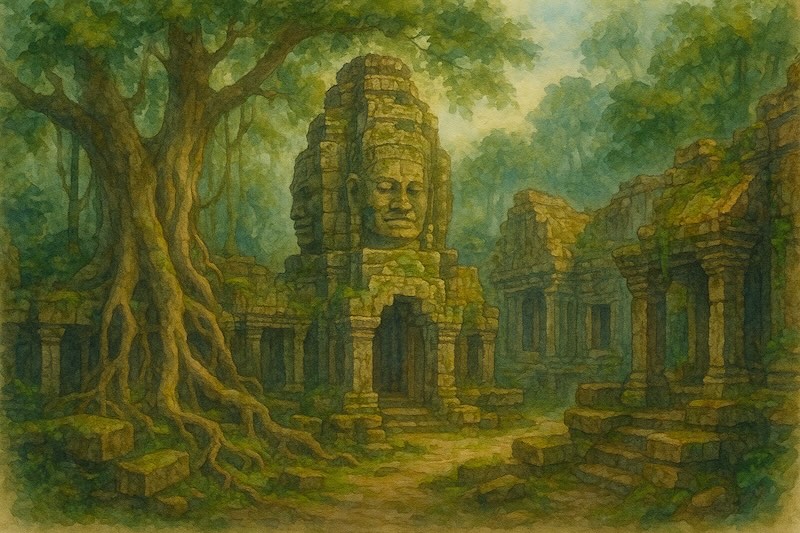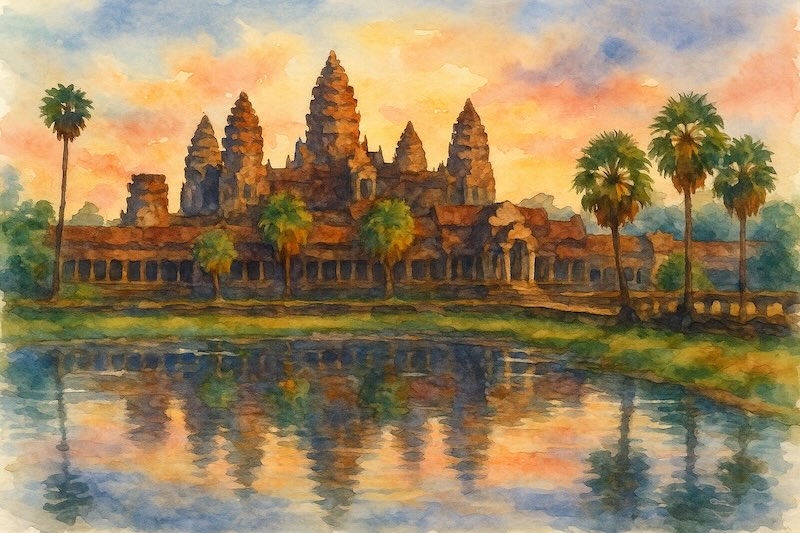Level 1 Reader
614 Words
A Very Old Temple
Angkor Wat is a very old temple. It is in Cambodia. It is over 800 years old. Long ago, it was the biggest city in the world. Now, it is a famous place to visit. Many people go to see it.
In the Jungle
Angkor Wat is in the jungle. There are many trees. There are many animals too. A long time ago, people lived there. But now, no one lives there. The jungle grew around the temple. It is quiet and green.
A Big Temple
Angkor Wat is very big. It is the biggest temple in the world. It is bigger than a football stadium. It has tall towers. It has big walls. It has long paths. You can walk and walk and not see all of it.
Made of Stone
Angkor Wat is made of stone. The stone is grey and brown. People used big stones to build it. They did not use machines. They used their hands and simple tools. It took many years to build. It was very hard work.
Many Pictures on the Walls
There are pictures on the walls. The pictures are in the stone. They show people, animals, and gods. The pictures tell stories. Some are about war. Some are about peace. Some are about life and death.

A Temple for the Gods
Angkor Wat was a temple. People prayed there. They prayed to Hindu gods. Later, people came and used the temple for Buddhism. So Angkor Wat is special for two big religions: Hinduism and Buddhism.
Sunrise and Sunset
Many people go to Angkor Wat early in the morning. They want to see the sunrise. The sun comes up behind the temple. The sky turns pink, orange, and gold. The towers of the temple look black in front of the light. It is very beautiful.
At sunset, the sky changes again. The temple looks golden. The light makes it glow. It feels like magic.
A Lost City
Many years ago, the city around Angkor Wat was lost. People moved away. The jungle took over. Big trees grew on the buildings. Roots broke the stone. For a long time, people forgot the city.
Later, explorers found it again. They told the world. Now, people work to fix it and keep it safe.
Monkeys and Tourists
Today, many people go to see Angkor Wat. They come from all over the world. They walk, take photos, and learn. Monkeys also live there. They jump and run. Sometimes they take food from people!
Visitors must be careful. They must not climb the walls. They must not touch the pictures. The temple is very old. It can break easily.
Climbing the Tower
There is a big tower in the middle. It is tall and steep. You can climb up. But the steps are high and small. It is hard to climb. At the top, you can see far. You can see the jungle and the sky. It is very quiet up there.
A Symbol of Cambodia
Angkor Wat is on the flag of Cambodia. It is very important to the people of Cambodia. It is a symbol of their history, their culture, and their strength.
UNESCO World Heritage
Angkor Wat is a UNESCO World Heritage site. This means it is very special. It is part of world history. People want to protect it. They want to keep it safe for many years.
Come and See
Angkor Wat is a special place. It is big. It is old. It is beautiful. It has many stories. If you go to Cambodia, you can see it. You can walk, look, and learn. It is a place you will never forget.
Level 2 Reader
515 Words
A Temple in Cambodia
Angkor Wat is a very old and beautiful temple in Cambodia. It is one of the most famous temples in the world. Many people come from different countries to see it.
The temple is near the city of Siem Reap. Long ago, it was in the middle of a busy city, but today it is surrounded by trees and jungle. Some people call it the “lost city in the jungle.”
A Temple for a King
Angkor Wat was built about 900 years ago, in the 12th century. It was made for a king named Suryavarman II. He wanted a big temple to show his power and his faith.
The temple was first built for the Hindu god Vishnu. Later, it became a Buddhist temple. Today, many people still visit to pray and give thanks.
Building the temple was not easy. Thousands of workers helped. They used stones from far away and moved them with elephants and boats. The workers cut and carved the stones by hand. The work took many years.
A Special Design
Angkor Wat is very big. It is the largest religious building in the world. There is a wide moat (a water-filled ditch) around the temple. It looks like the temple is on an island.
The shape of the temple is very special. From the top, it looks like a lotus flower. It has five towers. The middle tower is the tallest. It stands for Mount Meru, a holy mountain in Hindu stories.
Inside the temple, there are long walls with beautiful carvings. These pictures show gods, dancers, and stories from ancient times. One famous wall shows a story about a big ocean of milk and gods working together to make it turn.

Lost and Found
After many years, the Khmer Empire became weak. People stopped taking care of Angkor Wat. The jungle began to grow around it. For a long time, people in other countries did not know about it.
In the 1800s, a French explorer found the temple again. He told the world about the lost city. Many people were amazed. Since then, more and more people have come to visit.
Angkor Wat Today
Today, Angkor Wat is a UNESCO World Heritage Site. That means it is protected and important to all people in the world.
Many people work to take care of the temple. They fix broken parts and clean the carvings. They want to keep Angkor Wat safe for the future.
Tourists visit every day. They walk up the steep stairs, take photos of the towers, and enjoy the quiet beauty of the jungle. Some come in the early morning to see the sun rise behind the temple. It is a famous and peaceful view.
A Symbol of Cambodia
Angkor Wat is more than just a temple. It is a symbol of Cambodia. You can see its towers on the Cambodian flag. It shows the country’s long history, rich culture, and strong spirit.
For many people, Angkor Wat is not just a place to visit—it is a place to remember, respect, and love.
Level 3 Reader
600 Words
Introduction
In the heart of Cambodia lies one of the most fascinating monuments in the world: Angkor Wat. Built almost 900 years ago, this enormous temple complex is not only a symbol of Cambodia’s history, but also of its national pride. Every year, millions of visitors travel to see its towers rise above the jungle, its walls carved with detailed stories, and its reflection shimmering in the surrounding pools.
A Temple for a King
Angkor Wat was built in the early 12th century by King Suryavarman II. He wanted to create a temple that honored the Hindu god Vishnu and showed the strength of his empire. The Khmer Empire, which ruled over much of Southeast Asia at the time, was wealthy and powerful. Angkor Wat was a way for the king to show both his devotion and his greatness.
The temple was designed to represent Mount Meru, a sacred mountain in Hindu mythology believed to be the center of the universe. Its five towers symbolize the five peaks of the mountain, and the surrounding walls and moats represent the mountains and oceans.
An Architectural Wonder
Angkor Wat is the largest religious monument in the world. It covers more than 160 hectares and took several decades to complete. The stone blocks used to build the temple were transported from far away, and workers had to carry them across rivers and forests. Historians are still amazed at how such a large and complex structure was built without modern tools or machines.
The walls of Angkor Wat are covered in carvings that tell stories from Hindu epics like the Ramayana and the Mahabharata. These detailed images show gods, battles, and daily life in the Khmer Empire. One of the most famous carvings is the “Churning of the Ocean of Milk,” which shows gods and demons working together to create the elixir of life.
From Hinduism to Buddhism
Although Angkor Wat was originally built as a Hindu temple, it later became a Buddhist site. In the 14th century, as Buddhism spread across the region, the temple was adapted for Buddhist worship. Today, it remains an active spiritual site, with monks praying and visitors lighting incense in quiet respect.
This blending of religions is part of what makes Angkor Wat so special. The temple is not only a historical monument but also a living one—where the past and present come together in harmony.

Abandonment and Rediscovery
After the fall of the Khmer Empire, Angkor Wat was slowly abandoned. The jungle grew thick around the temple, hiding it from the world. However, it was never completely forgotten. Local people continued to care for the temple, and in the 19th century, Western explorers “rediscovered” it.
French naturalist Henri Mouhot visited Angkor in the 1860s and described it as “grander than anything left to us by Greece or Rome.” His writings brought Angkor Wat to the attention of the world, and efforts to preserve and study it began.
A Global Treasure
In 1992, Angkor Wat was declared a UNESCO World Heritage Site. Since then, international teams have helped restore and protect the temple from damage caused by time, weather, and tourism.
Today, Angkor Wat is more than a tourist destination. It is a source of pride for Cambodians and appears on the national flag. It represents not only a glorious past, but also the resilience of a culture that has survived war, colonialism, and hardship.
Visiting Angkor Wat is not just about seeing a temple. It is about walking through history, understanding the power of faith, and feeling the presence of something much greater than ourselves.
Extensive Listening
Level 1 Audio
Level 2 Audio
Level 3 Audio
Natural Discussion
AWS Polly & Google Notebook LM
Angkor Wat

Lectura nivel 1
578 Palabras
Un Templo Muy Antiguo
Angkor Wat es un templo muy antiguo. Está en Camboya. Tiene más de 800 años. Hace mucho tiempo, fue la ciudad más grande del mundo. Ahora, es un lugar famoso para visitar. Muchas personas van a verlo.
En la Selva
Angkor Wat está en la selva. Hay muchos árboles. También hay muchos animales. Hace mucho tiempo, la gente vivía allí. Pero ahora, nadie vive allí. La selva creció alrededor del templo. Es un lugar tranquilo y verde.
Un Templo Grande
Angkor Wat es muy grande. Es el templo más grande del mundo. Es más grande que un estadio de fútbol. Tiene torres altas. Tiene muros grandes. Tiene caminos largos. Puedes caminar y caminar sin verlo todo.
Hecho de Piedra
Angkor Wat está hecho de piedra. La piedra es gris y marrón. Las personas usaron piedras grandes para construirlo. No usaron máquinas. Usaron sus manos y herramientas simples. Tardaron muchos años en construirlo. Fue un trabajo muy difícil.
Muchas Imágenes en las Paredes
Hay imágenes en las paredes. Las imágenes están en la piedra. Muestran personas, animales y dioses. Las imágenes cuentan historias. Algunas son sobre la guerra. Algunas son sobre la paz. Algunas son sobre la vida y la muerte.
Un Templo para los Dioses
Angkor Wat era un templo. Las personas rezaban allí. Rezaban a los dioses hindúes. Después, otras personas usaron el templo para el budismo. Por eso, Angkor Wat es especial para dos religiones grandes: el hinduismo y el budismo.

Amanecer y Atardecer
Muchas personas van a Angkor Wat temprano en la mañana. Quieren ver el amanecer. El sol sube detrás del templo. El cielo se vuelve rosado, naranja y dorado. Las torres del templo se ven negras frente a la luz. Es muy hermoso.
Al atardecer, el cielo cambia otra vez. El templo se ve dorado. La luz lo hace brillar. Parece magia.
Una Ciudad Perdida
Hace muchos años, la ciudad alrededor de Angkor Wat se perdió. Las personas se fueron. La selva la cubrió. Grandes árboles crecieron en los edificios. Las raíces rompieron la piedra. Por mucho tiempo, la gente olvidó la ciudad.
Después, unos exploradores la encontraron otra vez. Le contaron al mundo. Ahora, la gente trabaja para arreglarla y cuidarla.
Monos y Turistas
Hoy, muchas personas van a ver Angkor Wat. Vienen de todo el mundo. Caminan, toman fotos y aprenden. También viven monos allí. Saltan y corren. ¡A veces toman comida de las personas!
Los visitantes deben tener cuidado. No deben subir a los muros. No deben tocar las imágenes. El templo es muy antiguo. Se puede romper fácilmente.
Subiendo a la Torre
Hay una torre grande en el centro. Es alta y empinada. Puedes subir. Pero los escalones son altos y pequeños. Es difícil subir. Arriba, puedes ver muy lejos. Puedes ver la selva y el cielo. Es muy tranquilo allí.
Un Símbolo de Camboya
Angkor Wat está en la bandera de Camboya. Es muy importante para el pueblo de Camboya. Es un símbolo de su historia, su cultura y su fuerza.
Patrimonio Mundial de la UNESCO
Angkor Wat es un sitio del Patrimonio Mundial de la UNESCO. Esto significa que es muy especial. Es parte de la historia del mundo. Las personas quieren protegerlo. Quieren cuidarlo por muchos años.
Ven a Verlo
Angkor Wat es un lugar especial. Es grande. Es antiguo. Es hermoso. Tiene muchas historias. Si vas a Camboya, puedes verlo. Puedes caminar, mirar y aprender. Es un lugar que nunca olvidarás.
Lectura nivel 2
510 Palabras
Un templo en Camboya
Angkor Wat es un templo muy antiguo y hermoso en Camboya. Es uno de los templos más famosos del mundo. Muchas personas vienen de diferentes países para verlo.
El templo está cerca de la ciudad de Siem Reap. Hace mucho tiempo, estaba en medio de una ciudad muy activa, pero hoy está rodeado de árboles y selva. Algunas personas lo llaman “la ciudad perdida en la selva”.
Un templo para un rey
Angkor Wat fue construido hace unos 900 años, en el siglo XII. Fue hecho para un rey llamado Suryavarman II. Él quería un gran templo para mostrar su poder y su fe.
El templo fue construido primero para el dios hindú Vishnu. Más tarde, se convirtió en un templo budista. Hoy en día, muchas personas todavía lo visitan para orar y dar gracias.
Construir el templo no fue fácil. Miles de trabajadores ayudaron. Usaron piedras de lugares lejanos y las movieron con elefantes y barcos. Los trabajadores cortaban y tallaban las piedras a mano. El trabajo tomó muchos años.
Un diseño especial
Angkor Wat es muy grande. Es el edificio religioso más grande del mundo. Hay un gran foso (una zanja llena de agua) alrededor del templo. Parece que el templo está en una isla.
La forma del templo es muy especial. Desde arriba, parece una flor de loto. Tiene cinco torres. La torre del medio es la más alta. Representa el Monte Meru, una montaña sagrada en los cuentos hindúes.
Dentro del templo, hay largos muros con tallados hermosos. Estas imágenes muestran dioses, bailarinas y cuentos antiguos. Un muro famoso muestra una historia sobre un gran océano de leche y dioses trabajando juntos para hacerlo girar.

Perdido y encontrado
Después de muchos años, el Imperio Jemer se volvió débil. Las personas dejaron de cuidar Angkor Wat. La selva empezó a crecer a su alrededor. Durante mucho tiempo, personas de otros países no sabían que existía.
En el siglo XIX, un explorador francés encontró el templo otra vez. Contó al mundo sobre la ciudad perdida. Muchas personas quedaron asombradas. Desde entonces, cada vez más gente viene a visitarlo.
Angkor Wat hoy
Hoy, Angkor Wat es un Sitio del Patrimonio Mundial de la UNESCO. Eso significa que está protegido y que es importante para toda la humanidad.
Muchas personas trabajan para cuidar el templo. Reparan partes rotas y limpian los tallados. Quieren mantener Angkor Wat seguro para el futuro.
Turistas lo visitan todos los días. Suben las escaleras empinadas, toman fotos de las torres y disfrutan la belleza tranquila de la selva. Algunos vienen muy temprano para ver salir el sol detrás del templo. Es una vista famosa y pacífica.
Un símbolo de Camboya
Angkor Wat es más que un templo. Es un símbolo de Camboya. Puedes ver sus torres en la bandera del país. Representa la larga historia, la rica cultura y el espíritu fuerte del pueblo camboyano.
Para muchas personas, Angkor Wat no es solo un lugar para visitar—es un lugar para recordar, respetar y amar.
Lectura nivel 3
638 Palabras
Introducción
En el corazón de Camboya se encuentra uno de los monumentos más fascinantes del mundo: Angkor Wat. Construido hace casi 900 años, este enorme complejo de templos no solo es un símbolo de la historia de Camboya, sino también de su orgullo nacional. Cada año, millones de visitantes viajan para ver sus torres elevándose sobre la selva, sus muros tallados con historias detalladas y su reflejo brillando en los estanques que lo rodean.
Un templo para un rey
Angkor Wat fue construido a principios del siglo XII por el rey Suryavarman II. Quería crear un templo que honrara al dios hindú Vishnu y que demostrara la fuerza de su imperio. El Imperio Jemer, que gobernaba gran parte del sudeste asiático en ese tiempo, era rico y poderoso. Angkor Wat fue una forma de mostrar tanto su devoción como su grandeza.
El templo fue diseñado para representar el monte Meru, una montaña sagrada en la mitología hindú que se cree es el centro del universo. Sus cinco torres simbolizan los cinco picos de la montaña, y los muros y fosos que lo rodean representan las montañas y los océanos.
Una maravilla arquitectónica
Angkor Wat es el monumento religioso más grande del mundo. Cubre más de 160 hectáreas y tomó varias décadas completarlo. Los bloques de piedra usados para construir el templo fueron transportados desde lugares lejanos, y los trabajadores tuvieron que llevarlos a través de ríos y bosques. Los historiadores aún se asombran de cómo una estructura tan grande y compleja fue construida sin herramientas ni máquinas modernas.
Los muros de Angkor Wat están cubiertos de tallas que cuentan historias de epopeyas hindúes como el Ramayana y el Mahabharata. Estas imágenes detalladas muestran dioses, batallas y la vida cotidiana del Imperio Jemer. Uno de los relieves más famosos es el de “El Batido del Océano de Leche”, que muestra a dioses y demonios trabajando juntos para crear el elixir de la vida.
Del hinduismo al budismo
Aunque Angkor Wat fue construido originalmente como un templo hindú, más tarde se convirtió en un sitio budista. En el siglo XIV, a medida que el budismo se extendía por la región, el templo fue adaptado para el culto budista. Hoy en día, sigue siendo un lugar espiritual activo, con monjes que rezan y visitantes que encienden incienso con respeto y silencio.
Esta mezcla de religiones es parte de lo que hace a Angkor Wat tan especial. El templo no es solo un monumento histórico, sino también uno vivo—donde el pasado y el presente se unen en armonía.

Abandono y redescubrimiento
Tras la caída del Imperio Jemer, Angkor Wat fue abandonado poco a poco. La selva creció espesa alrededor del templo, ocultándolo del mundo. Sin embargo, nunca fue completamente olvidado. La gente local siguió cuidando del templo, y en el siglo XIX, exploradores occidentales lo “redescubrieron”.
El naturalista francés Henri Mouhot visitó Angkor en la década de 1860 y lo describió como “más grandioso que cualquier cosa que nos haya dejado Grecia o Roma”. Sus escritos llevaron Angkor Wat a la atención del mundo, y comenzaron los esfuerzos para preservarlo y estudiarlo.
Un tesoro global
En 1992, Angkor Wat fue declarado Patrimonio de la Humanidad por la UNESCO. Desde entonces, equipos internacionales han ayudado a restaurar y proteger el templo de los daños causados por el tiempo, el clima y el turismo.
Hoy en día, Angkor Wat es más que un destino turístico. Es una fuente de orgullo para los camboyanos y aparece en su bandera nacional. Representa no solo un pasado glorioso, sino también la resiliencia de una cultura que ha sobrevivido guerras, colonialismo y dificultades.
Visitar Angkor Wat no se trata solo de ver un templo. Es caminar por la historia, comprender el poder de la fe y sentir la presencia de algo mucho más grande que nosotros mismos.
Escucha extensiva
Nivel 1 audio
Nivel 2 audio
Nivel 3 audio
Discusión natural
AWS Polly & Google Notebook LM

